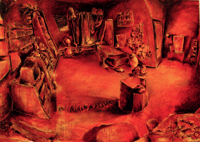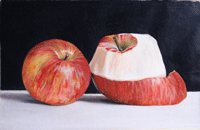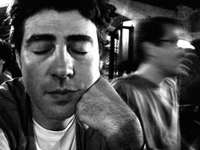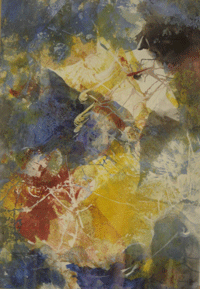August 9, 2006
Something About Us

"Something About Us"
Museu de Tossa de Mar, Costa Brava, Spain.
August 12th to September 12th, 2006.
I. Post Script as Prologue: Changing Hats
Like the reverse chronological arrangement of a weblog, what s usually presented as an after thought must here be inserted into the beginning of an apologetic text introducing the show curated by Alberto Barcia Fernandez at the Museo de Tossa de Mar entitled "Something About Us". Like an ever evolving diary, the curator's idea and approach to mounting this show involving artists known by him in and around Tossa de Mar changed from day to day, week to week. The changes always converged on the same subject or strategy: the open question of what the sum of these artists gathered here amount to... what changed constantly were the tactics of presenting the artwork itself. As the military theorists say: "The first victim of battle is the battle plan.", an idea which is familiar and natural to most artists for time immemorial.
It is important to remember that the art world as we know it is young, minted perhaps in Picasso's Paris, codified and consolidated into the form that we know it to be in today in Pollock's New York. I like to think of the artworld as an aquarium wherein to sustain sea life, you need several elements to intermingle: oxygenated water of course, fish that eat from the bottom, fish that eat from the top, plants, sand, rocks to hide in... the list goes on but ultimately it is limited and concise. So too, an artworld needs a concise list to constitute it existentially: the oxygenated water is artwork and the conversations surrounding them, artists of course from bottom feeders to top feeders, critics, museums, collectors, cities to make the art in... this list too, goes on. Of course our world and our artworld changed since the formative years of Abstract Expressionist New York. Then, the artworld population probably numbered in the small thousands and today I would estimate our population exploded into several millions. The genres of art multiplied beyond the immortal three of painting, sculpture and drawing into multimedia's multitude. Another important change today is that artworld actors are changing roles with greater frequency: curators think of themselves as artists; artists become gallerists and visa versa; collectors curate; critics have morphed into mere writers or conversely into historians; museums have overtaken the role of galleries with the recent presentation of contemporary art, thus opening up the Pandora's Box known to some in the artworld as the "legal insider trading" of art-as-investment in the primary art market; the list can go on but I assume that by now, you might get the point.
Artists have too engaged in changing roles especially for those artists who specialized in multiple genres such as the famous yet recently deceased Jason Rhoades. Warhol's span into film and beyond is legendary and of course there is the great Martin Kippenberger, that legendary outlaw artist who knew no boundaries when it came to genre in art. Painters, however, have a strange position in this story. While installation artists can easily enlist the help to manifest a show from a gallery or museum both monetarily and otherwise, the idea that a painter can or should change the physical context of an exhibition space is not widespread and indeed there is a kind of typological ghetto that painters must conform to to garner a strange kind of status however now less regarded yet set apart as a special perhaps august category.
The curator of "Something About Us", Alberto Barcia Fernandez, is nominally a painter. He is a young artist and perhaps it is too early to affix a label onto him, but the identity that he first gravitated to was that of a painter. And the central question for him was how he should approach the design of the installation of this show. It is strange that this might be a new idea, but Alberto's disposition was to dispose this show as an artist would: to use the artwork and the artifacts of the artists' lives as his art material. How can one use such unusual art material? How can a life (the artifacts indicating the worldview of each artist) and a avatar of an oeuvre (the single representative art work) be used as one would wield a pencil, or pastel, or paint, or marble and bronze, or as is normative in today's exploded world: anything within one's reach? When one is drawing, a line is pulled and distinctions are made and when one flows liquid paint, distinctions ooze and boundaries melt. How can a curator draw and ooze? When one is sculpting or rendering, one displaces intentions by looking, harmonizing the twitch of the fingers with the regard for the subject. How can a curator regard a subject -in this case, this group of artists- and render with the twitch of the fingers an image in a formal exhibition?
II. Interlude: A River
A mist in the mountaintops, melting snow.
Condensate.
A very cold stream falling down the rocks, spilling faster and faster.
Streams join into rivers that widen, the water darkens, thickens, warms.
The river broadens it seems to slow.
And then it meets the sea in a delta. Oozing, fetid, muddy, water steaming into the sky.
Evaporate.
III. "Something About Us"
Resist your desire to be told how to think about this show.
It's a natural response. "Why have I been brought here? What is this all about? How should I think about what I am seeing?" Yet perhaps you are still entitled to an answer. How else can you begin to determine the worth of the experience that is now presented to you? "What is the story behind what we are seeing?"
What is presented here in the exhibition "Something About Us" is not so much the artworks themselves, but a hanging question as what they all add up to. Hanging is not always a pleasant experience to be sure and the unpleasantness ranges mildly from a missed appointment to something as brutal as lynching. One can be "hung up" as in the song "Bewitched, Bothered and Bewildered." and that's not much fun however obsessively or romantically preoccupying it might become. There are however, more appealing aspects: think instead of "hanging out", an activity which in itself a happily open question.
The sculpture of Richard Serra comes to mind in a streak of work he called "Prop" wherein he took two sheets of lead and... propped one flat up on the wall with the other buttressing in a rolled up form. The king of Minimalist sculpture, Serra pointed to a paradoxically disembodied experience: gravity. A sculptor of gravity, his tilted arcs and steel cubes several meters to a side seem to bring an achingly palpable sense to gravity's field. Indeed, the trajectory of the PostModern turn was into the direction of the disembodied. Instead of the Modernist transcendent reach towards G-d through material means, the revolution in the 60's was to touch everyday life through conceptual means. And this revolution has churned for quite a long time now. For example, the generational turn of sculptor Charlie Ray in Los Angeles opened up the disembodied subject into other territory than the classical categories of the type that noble gravity would belong to. Instead of steel or lead, Charlie Ray used himself as material and lens for psychosocial fields, perhaps a cultural version of gravity. Through it all and for forty years of permutation, we have been presented with some-thing and asked to see a non-thing, nothing that can be touched. "Something about us" is perhaps like this but finally, it is different.
But let us not leave you all hanging in a bad way... let us therefore jump to the end of this argument and state flatly that our curator, Alberto Barcia Fernandez, has presented not so much a collection of individual artworks but an open question. With this show we have been presented with a "no-thing" or better, a "some-thing-about " and we are asked therefore to see very real things, the work of the various artists in this show. This bears repeating: we have been presented with a no-thing and we are asked to see some-things.
What is more, we are asked to consider something about... us. Specifically, these are artists local to Alberto's experience, artists working in the heart of the Costa Brava. Immediately the question is heightened as to who we are and this question is extended from the "us" of the artists in the show to the "we" of the character of the inhabitants of the Costa Brava. "Who are they?" becomes "Who are we?" Indeed the curatorial thesis of this exhibition is a militant one, restless. The word "some" is an open and incomplete assessment. The word "thing" is an anchor but like an anchor for a boat, it is at best furtive and temporary. Nomadic, and like the nautical anchor, it is ultimately a point from which the wind can spin you around with. As for the word "about"... what a word. It is an idea held forever aloft; cloud hidden, whereabouts unknown; a command in abeyance; active like a maritime search at the last point of contact; and ultimately for this show, a conjecture.
Reality as conjecture.
An old friend and colleague in graduate school, artist Marcus Adams used to say that "...art is that which is presented for its' aesthetic appreciation..." and that the aesthetic comes from the Greek as in sense perception, which can be understood contrarily if you consider the meaning of anesthetic as given into English by Oliver Wendell Holmes to signify insensibility. The ramifications of this train of definitions is that the idea that art is presented less for a consideration of its beauty but that beauty might instead be something interesting. In the former, the idea of beauty is a closed, conforming and foregone conclusion. In the latter, beauty is bound with curiosity, open as an unanswered question.
The task of talking about art is similar to the way poetry talks about life, which is to surround and frame the world. The aesthetic grasp of reality cups but does not crush. The way to talk about art is to lasso it with words, to surround and encircle it as carefully as grasping dandelions or capturing soap bubbles in midair. Therefore as in a bouquet of dandelions, what artworks constitute our bouquet, just who are the artists that Alberto Barcia Fernandez has presented to us for our aesthetic appreciation?

Victor Jimenez Guri

Rafa de la Rica

Enric Montejano

Annemarie Otten

Daniel Herrera
(Image to be inserted)
Luis Casado Casardo
(image to be inserted)
Dennis Hollingsworth
Leave a comment